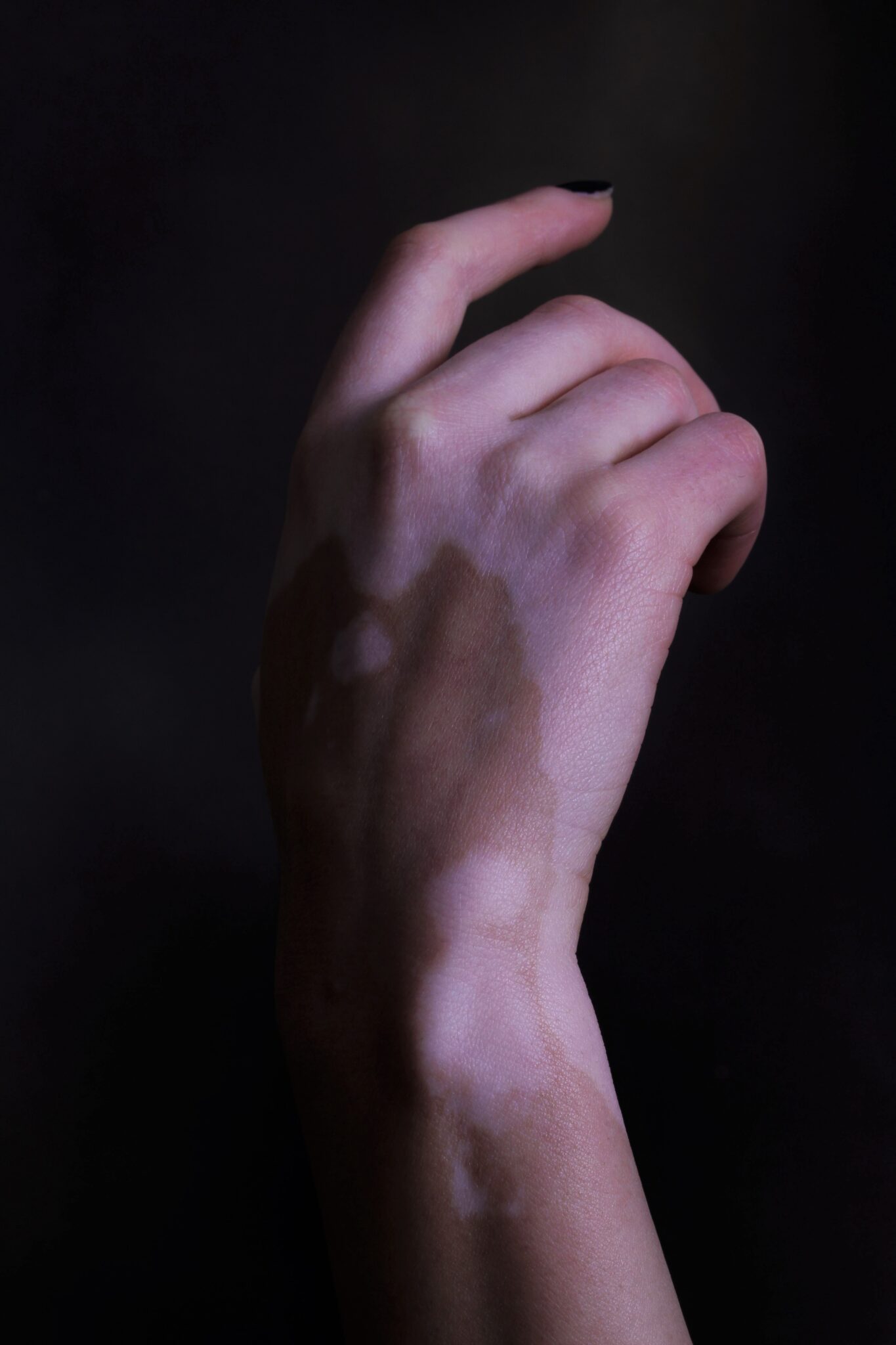
Reviewed by:
Nicole A. McCarthy, MD MSc

Reviewed by:
Nicole A. McCarthy, MD MSc

Vitiligo
By: Narda McCarthy
Febrero 20, 2022
Vitiligo is a chronic, inflammatory, autoimmune disease with possible genetic components. Its exact causes are still not clear to the scientists. Research suggests it to be an autoimmune disease which means that the body recognizes its own components as foreign and acts against itself, in the case of vitiligo, killing the melanocytes causing patches of skin to lose pigment and turn a milky-white color. As per the United States National Institutes of Health, our autoimmune system works throughout your body to fight off and defend your body from viruses, bacteria, and infection. In people with autoimmune diseases, the immune cells attack the body’s own healthy tissues by mistake.
Research continues to determine how family history and genes may play a role in causing vitiligo.
According to the Academy of Dermatology, vitiligo does not have any preference about individuals. It targets all skin colors and races; pretty much fifty percent male and fifty percent female.
NOTE: This condition is not life-threatening or contagious.
We see, then, that anyone can get vitiligo, and although it can raise its head at any age, in many cases, the white patches start appearing before individuals reach 20 years of age and in some instances, it starts in early childhood.
It is challenging to foresee its progress because sometimes the patches stop forming without treatment. In most cases, though, pigment loss stretches until it involves most of your skin. However, there have been cases in which the skin gets its color back.
Although there is no cure for vitiligo, treatment may help even the skin tone, but it will not prevent its continued development or a recurrence.
According to the United States National Institute of Arthritis and Musculoeskeletal and Skin Diseases there are two types of vitiligo:
- Non-segmental vitiligo may be an autoimmune disease. This is the most common, therefore, also called generalized vitiligo. Its white patches appear symmetrically on both sides of the body, such as on both hands or knees. It develops fast, covering a large area.
- Segmental vitiligo is less common and happens when the white patches are only on one side of the body: A leg, one side of the face, one arm. This type of vitiligo frequently begins at an early age progressing in the next 1 to 2 years and then, frequently, stops. It seems that this type of vitiligo develops when something in the body’s nervous system goes amiss or after a significant activation of the immune system.
You may find a specialist experienced in treating vitiligo through support organizations, clinical trials, medical journals, university hospitals, or specialized medical centers. A specialized medical center more likely will have experience in complex cases besides having access to the latest technology and treatments.
NOTE: Tell your doctor immediately if you see signs of discoloration on your skin, hair, or mucous membranes. Ask them to recommend a specialist who has experience on this disease. Early treatment might stop or at least slow the disease’s progress and maybe, return some color to your skin.
It is important to consult with a specialist as vitiligo could be confused with other conditions caused by exposure to some industrial chemicals, albinism, some yeast infections, or red and scaly areas that are known as pityriasis alba.
INTERESTING EVIDENCE: Although there is not a known cure, some individuals have reported full re-pigmentation.
Be prepared when you see the specialist. Write down all your observations and your questions. Visit your family history to find out any presence of vitiligo; write down about stressful events and chemicals you might have been in contact with, including changes in your skin care products, dish or laundry detergent, etc. If you need support, do not hesitate to ask a trusted person to go with you to the appointment.
Causes, risks, intensifiers:
- A close blood relative who has or had the disease
- Other auto immune disease
- A bad sunburn
- Emotional distress
- Hormonal changes, child to adolescent
- Liver or kidney problems
- Exposure to products that contain phenol (carbolic acid/phenic acid) such as: Some adhesives, deodorants, disinfectants, detergents, insecticides, latex gloves, some paints, chemicals used in photography, printing, and carpentry
Symptoms:
- Depigmentation: Milky-white patches on the skin (hands, feet, arms, face) and mucous membranes (inside your mouth, nose, or genitals); white hair (scalp, eyebrows, eyelashes, beard)
- Inflammation or swelling in the eyes (Uveitis)
- Inflammation in the ears
Possible consequences:
- Low self-esteem
- Poor self-image
- Social or psychological anguish
- Sunburn
- Other auto immune diseases
- Eye problems
According to the Harvard review article “Vitiligo: More than skin deep” by Kristina Liu, vitiligo affects approximately 1% of the population
As per the Global Vitiligo Foundation:
- 70 million people across the world have vitiligo
- 20-35% of patients are children.
- There is very little research funding for vitiligo
- Many of the currently available treatments are not covered by insurance
WHAT TO DO:
- Ginko biloba. No more than 120 grams per day. Do not use if you are taking anti coagulants and let your doctor know you are taking it before a medical procedure
- Turmeric and Mustard paste: Taking two tablespoons of good-quality turmeric powder add enough mustard oil to make a light paste. Apply to desired areas and leave on for 20 minutes. Rinse with warm water. Apply twice a day at least for two weeks. If you need to, rest for one week and reapply. When using this solution, please keep in mind that turmeric stains, therefore the use of something loose and that you don’t mind staining is recommended.
- Sprinkle nutritional yeast over pasta, popcorn, salads, soups. Its cheesy flavor will be a plus. Nutritional yeast, also referred to as nooch, is a vast source of probiotics, potassium, zinc, vitamins B1, B2 and B6. It also has protein, fiber, and amino acids. Use wisely, no more than three tablespoons per day. Its high fiber content could cause stomach discomfort.
- Take a few fresh margosa (Azadirachta Indica), leaves, add one tablespoon of honey and let it rest for a few minutes. Sieve and take this mixture once a day. No more than two teaspoons per day and never more than 40 days (margosa could affect your liver). You can also add a few dry margosa leaves to regular tea leaves in a tea pot (margosa is bitter) and take no more than two cups a day.
- Margosa, also known as neem, is good for many conditions, however, it should always be consumed carefully and never, never, give it to infants, children, pregnant or lactating mothers. Margosa has been found to be responsible for side effects that range from vomiting to death in children and miscarriages in pregnant mothers.
- Bakuchi or babchi (Psoralea carylifolia): Known as a good anti-inflammatory and a great aid to increase pigmentation. However, avoid eating curds, pickles and fish when you use any of the three solutions below.
- Make a paste mixing well bakuchi with vinegar to make a fine and light paste, apply rubbing it gently, let it dry and wash.
WHAT TO DO, CONT.
- Early in the morning, mix bakuchi oil with an equal part of coconut oil, apply on affected area, rubbing it lightly; expose it to the morning sun for a short period of time, wash.
- Soak bakuchi and tamarind seeds in water for four days, using the blender, make a fine paste and apply. Let it dry and wash.
- Using unadulterated blackberry juice, put two spoons in ½ cup of witch hazel in a dark, glass bottle, close tightly, shake and rub it on the affected area. Keep it in the fridge no more than two weeks.
- Ginger juice: Take approximately two inches of a ginger root and blend it with eight ounces of water. Sieve it and drink. Do this twice a day.
- Figs: Eat them daily. It is recognized as effective, although slow to show its good effects.
- Clarified butter (ghee) and black pepper: Heat 10 pepper corns in 10 grams of butter. Remove the pepper and add the same amount of butter without the pepper. Add this butter to your food every day. It will help purify your blood stream, strengthening your immune system.
- Before breakfast, mix one teaspoon of powdered dry pomegranate leaves in a glass of water and drink. Do this every morning.
- Add alfalfa and cucumber to your smoothies, salads or sandwiches.
- Add cayenne pepper to your diet. It will add zest to your soups, sauces, rice, stews and salads.
- Pigweed (Chenopodium album). Make a delicious smoothie with apples, pears, dates, chia, spinach and pigweed. Make a delicious soup with zuchinni and leeks. Serve with croutons… Mhhh. Mix with ricotta and feta cheeses for a delicious dip. Also good as an infusion.
- Include zinc, vitamins D, B12 and folic acid in your daily routine.
- Keep yourself well hydrated, very important for your skin’s health
- Cod liver oil is a great source of vitamin D
- Identify foods that cause you allergies or upset your stomach or intestines and avoid them
Include in your diet:
- Yams, pumpkin, carrots, kale and tomatoes. Delicious and powerful, protect your skin, reduce inflammation, and stimulate eye health
- Aloe, can be taken orally and also used topically: Add to your smoothies, blend with orange juice
- Fresh fruits and vegetables containing vitamin C
- Raw milk, raw dairy products and eggs
- Wild-caught sardines, salmon, mackerel or tuna
- Enjoy at least one daily serving of green leafy vegetables like kale, spinach, Swiss chard
- At least twice a week: Brussel sprouts, beets, radishes, carrots, asparagus, mushrooms
- Cottage cheese, Latin American cheeses like queso fresco, queso de mano
- Chickpeas and lentils
- Grass-fed beef and liver (good to include for all auto-immune diseases)
- Almonds (good for almost every malady)
- Dark chocolate
- Blackstrap molasses
Extra tips:
- Consider counseling
- Find a support group
- Consider light therapy
- Sunscreen with an SPF 30 or higher, UVB, UVA
- Some research indicates that mild sun exposure at the same time that some medicaments, can be beneficial, research carefully
- Special camouflage makeup
- Hair dyes
- Practice Yoga, meditation, visualization
- Exercise regularly
- Join support groups
- Include massage as a relaxation practice
- Avoid: citrus fruits, reportedly they could reduce pigmentation. Carbonate drinks, processed foods, alcohol, artificial sweeteners, tight clothing
Share your results with us on Instagram
Photography by: Ankshou Purkait, Carolina Heza, Clay Banks, Dekler-Ph, Hanen Boubahri, Mohamed Hassan @ Unsplash





